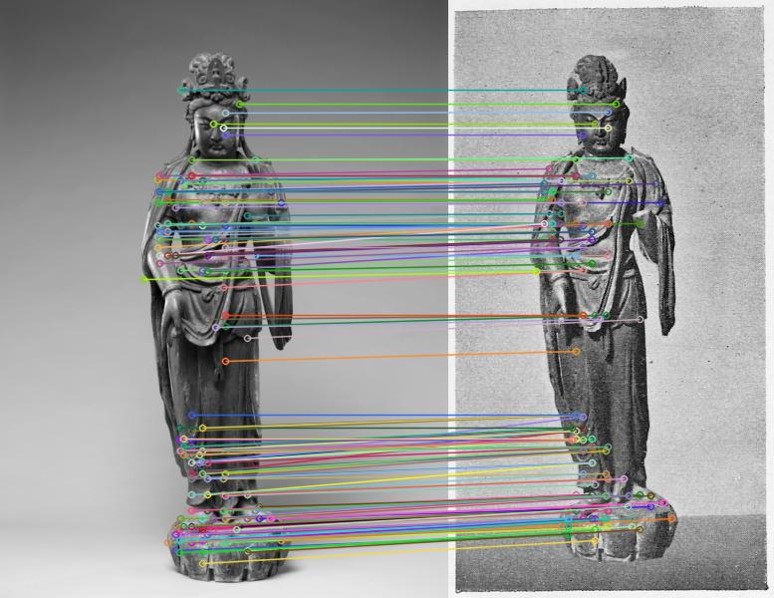Searching for Images with Artificial Intelligence
Computer vision experts at Fraunhofer IPK have been commissioned by the Rhineland Regional Council to explore how AI-based image search methods can be used in provenance research. Using the »German Sales« database as an example, they show how art objects in auction catalogs can be identified automatically in order to reconstruct the history of their provenance.
Auction catalogs are an important resource for art historians and provenance researchers. They document where a work of art comes from, who it once belonged to, and into whose possession it changed, often over several centuries. »German Sales«, a database by the Heidelberg University Library, the Kunstbibliothek of the Staatliche Museen zu Berlin, and the Getty Research Institute in Los Angeles, among others, digitally records and centrally collects information on the historical art market in Germany, Austria, and Switzerland. Around 11,000 auction catalogs as well as gallery, storage, and antiquarian catalogs are available here online and via open access. But the plans for the database go beyond this: »Automated identification of cultural assets or art objects in online catalogs would make it easier to research the whereabouts of objects at specific times as well as stored data in the publications and thus obtain valuable information about owners,« says Guido Kohlenbach, head of the Department of Culture at the Rhineland Regional Council (Landschaftsverband Rheinland).
As part of a feasibility study, scientists at the Fraunhofer Institute for Production Systems and Design Technology IPK have therefore investigated the extent to which modern computer vision technologies can help in the search for art objects in digital auction catalogs. For this purpose, they developed AI-based image search methods that can reliably match images or art objects. The methods were validated using pairs of images, each representing matches between auction catalogs and other digital image collections. The researchers were confronted with the challenge that images of one and the same art object can vary greatly depending on the date and technique of image acquisition, image quality, perspective, or even the type of object itself (2D or 3D).
The preparation and quality assurance of the image data therefore played a central role in the project, starting with the extraction of images from over 9,100 auction catalogs of the »German Sales« database. »Due to the large number of images, purely manual processing would be very time-consuming and expensive,« explains Raúl Vicente-García, project manager at Fraunhofer IPK. »That‘s why we are using state-of-the-art computer vision methods that have proven themselves in the automated analysis and segmentation of documents, and adapting them with the help of AI to the special features of historical images.«
The results of the feasibility study are promising: About 560,000 images of paintings and sculptures, but also everyday objects such as furniture or cutlery, can be searched within a few seconds using the Fraunhofer methods. AI-based image characteristics are detected for each individual object in order to achieve a high recognition rate despite the high variability in the type and quality of the images. The features, which are automatically analyzed on different scales, range from contours and textures to object details such as the eye of a person depicted. Thanks to the adaptability of the AI-based processes, it is also possible to compare current and historical images, which may have a much lower image quality.
The feasibility study proves that AI-based image search methods are also suitable for provenance research. On the occasion of the successful completion of the study, Milena Karabaic, Head of the Department of Culture and Regional Cultural Heritage at the Rhineland Regional Council, emphasizes the great ethical and moral responsibility for proactive provenance research: »One of the central tasks of the Rhineland Regional Council is to preserve and research cultural assets and make them accessible to the public. This applies in particular to the area of provenance research. With the „Joint Declaration“ of the federal government, the federal states and the central municipal associations in 1999, Germany also committed itself to locating cultural property seized as a result of Nazi persecution and returning it to its rightful owners.« The future development of a prototype software solution to support provenance researchers could contribute to this.
The feasibility study on the use of AI-based image search methods for provenance research was conducted by Fraunhofer IPK on behalf of the Rhineland Regional Council and with the support of Heidelberg University Library and the international Arbeitskreis for Provenienzforschung e. V. (Research Association for Provenance Research).

 Fraunhofer Institute for Production Systems and Design Technology
Fraunhofer Institute for Production Systems and Design Technology